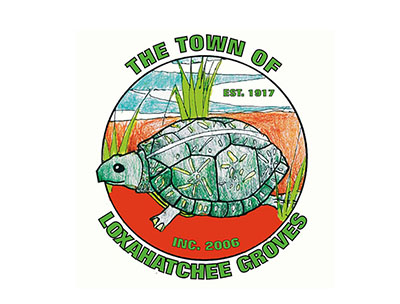The Loxahatchee Groves Town Council heard an update on Tuesday, Oct. 17 on plans by a contractor to set up a debris collection site in the community to be activated solely after a major storm.
The presentation was led by Brian Thomason of Ashbritt, which is contracted for disaster response services in the town, piggybacked off their agreement with the Solid Waste Authority.
Thomason’s update had been delayed due to his company’s work in the aftermath of Hurricane Idalia in North Florida. Previously, Ashbritt discussed with the town a number of potential temporary debris collection sites.
“We previously went over a list of possible properties to temporarily hold disaster storm vegetation,” Thomason said, noting that the focus has now shifted to one specific site at 248 C Road, just off Southern Blvd.
This site meets the criteria set up by the town, Ashbritt and the Solid Waste Authority, which would ultimately be running the site in the wake of a storm.
There are 16 usable acres at the site with no known wetland or animal impacts. The land is usually used as a depot. It would be set up as a five-year contract, but only activated as needed. Hours of operation can be limited by the town, and no burning is planned on the site.
The agreement is being negotiated between Ashbritt and the property owner, which is Brown Landholding. It would be underneath the SWA’s operating contract, which has set rates for this type of work. This agreement would not allow town exclusivity for the site, but Loxahatchee Groves would have priority for use of the site.
“This would not be a continuing vegetative debris site,” Town Manager Francine Ramaglia stressed. “This is an emergency debris site. Priority means that our town would be cleaned first.”
The contract would go into effect only when an emergency is declared, she noted. The contract is between the SWA and the property owner, subject to approval by several state agencies.
While some council members expressed concerns that debris from other communities would specifically be brought to Loxahatchee Groves, Thomason said that is unlikely. The rules for where storm debris goes are decided by the SWA based on the closest location.
Ramaglia explained that exclusivity is no longer included because the town cannot afford the cost of running the site itself, which is the only way to guarantee exclusivity. Wellington, for example, runs its own storm debris site on village-owned land. Wellington then pays for everything until it is eventually reimbursed by the Federal Emergency Management Agency (FEMA).
In this case, the SWA would run the site and bear all the costs, eventually paid by FEMA. Once debris gets to the site, the town is no longer responsible for it.
The discussion at the meeting was an update, not a final approval of the site. First Ashbritt needs to complete the agreement with the property owner and provide a site plan about how the land would be used, then the council will approve the plan via ordinance.
John Archambo, previously with the SWA but now working with Ashbritt, said that there are at least 11 SWA debris sites strategically located throughout the county.
“This site is not going to become a dumping ground in any way,” he said. “These haulers are paid by the cubic yard, so they go to the nearest temporary debris site.”
The SWA would run it like they do the others, and there would be a monitoring company there to oversee it, he said, adding that everything will get turned back to how it was before the storm. After previous storm events, public parks have been used for this purpose.
Most of the debris, about 90 percent, is projected to be yard waste and trees, up to 300,000 to 500,000 cubic yards of waste, Archambo explained.
“Grinders immediately get to work to reduce the piles, then it is hauled out to its final destination,” he said, noting that most vegetative debris goes to the sugar cane fields, which helps them because it provides a higher crop yield.
Vice Mayor Robert Shorr was not happy that the debris plan has been in discussion for months but is nowhere near a final agreement. “I guess this is getting ready for next year,” he said, asking where the next closest sites are.
Archambo said that there are sites at 20-Mile Bend and at Benoist Farms Road.
Councilwoman Marge Herzog asked how long the site would be in operation.
Thomason said that emergency work could be ongoing as long as six months, but usually less, depending on the impact of the storm and how much debris is created. He noted that the Hurricane Idalia cleanup will wind down after 90 days.
The next step in the process is inspections of the site by outside agencies, then a proposal will come to the town for approval.
In other business, the council decided against approving a proposed ordinance that would have removed some authority from the Loxahatchee Groves Planning & Zoning Board, giving it to the council directly.
The idea was raised at the council’s Oct. 3 meeting as a potential solution to the slow pace of the planning board in reviewing council priorities.
The key issue that kicked off the concern was a review of the proposed changes to town rules regarding recreational vehicles (RVs), which are up for final approval at a special meeting of the council set for Monday, Oct. 23 at 4 p.m.








